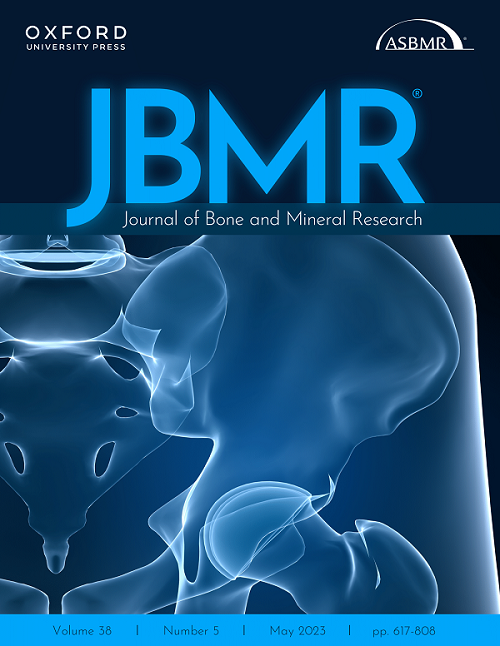Thang Dao, Dale Lee Robinson, Lex W Doyle, Peter VS Lee, Joy Olsen, Ashwini Kale, Jeanie LY Cheong, John D Wark
下载PDF
{"title":"Quantifying Bone Strength Deficits in Young Adults Born Extremely Preterm or Extremely Low Birth Weight","authors":"Thang Dao, Dale Lee Robinson, Lex W Doyle, Peter VS Lee, Joy Olsen, Ashwini Kale, Jeanie LY Cheong, John D Wark","doi":"10.1002/jbmr.4926","DOIUrl":null,"url":null,"abstract":"<p>The long-term bone health of young adults born extremely preterm (EP; <28 weeks' gestation) or extremely low birth weight (ELBW; <1000 g birth weight) in the post-surfactant era (since the early 1990s) is unclear. This study investigated their bone structure and estimated bone strength using peripheral quantitative computed tomography (pQCT)-based finite element modeling (pQCT-FEM). Results using this technique have been associated with bone fragility in several clinical settings. Participants comprised 161 EP/ELBW survivors (46.0% male) and 122 contemporaneous term-born (44.3% male), normal birth weight controls born in Victoria, Australia, during 1991–1992. At age 25 years, participants underwent pQCT at 4% and 66% of tibia and radius length, which was analyzed using pQCT-FEM. Groups were compared using linear regression and adjusted for height and weight. An interaction term between group and sex was added to assess group differences between sexes. Parameters measured included compressive stiffness (<i>k</i><sub><i>comp</i></sub>), torsional stiffness (<i>k</i><sub><i>torsion</i></sub>), and bending stiffness (<i>k</i><sub><i>bend</i></sub>). EP/ELBW survivors were shorter than the controls, but their weights were similar. Several unadjusted tibial pQCT-FEM parameters were lower in the EP/ELBW group. Height- and weight-adjusted <i>k</i><sub><i>torsion</i></sub> at 66% tibia remained lower in EP/ELBW (mean difference [95% confidence interval] −180 [−352, −8] Nm/deg). The evidence for group differences in <i>k</i><sub><i>torsion</i></sub> and <i>k</i><sub><i>bend</i></sub> at 66% tibia was stronger among males than females (<i>p</i><sub>interactions</sub> <0.05). There was little evidence for group differences in adjusted radial models. Lower height- and weight-adjusted pQCT-FEM measures in EP/ELBW compared with controls suggest a clinically relevant increase in predicted long-term fracture risk in EP/ELBW survivors, particularly males. Future pQCT-FEM studies should utilize the tibial pQCT images because of the greater variability in the radius possibly related to lower measurement precision. © 2023 The Authors. <i>Journal of Bone and Mineral Research</i> published by Wiley Periodicals LLC on behalf of American Society for Bone and Mineral Research (ASBMR).</p>","PeriodicalId":185,"journal":{"name":"Journal of Bone and Mineral Research","volume":"38 12","pages":"1800-1808"},"PeriodicalIF":5.1000,"publicationDate":"2023-10-18","publicationTypes":"Journal Article","fieldsOfStudy":null,"isOpenAccess":false,"openAccessPdf":"https://onlinelibrary.wiley.com/doi/epdf/10.1002/jbmr.4926","citationCount":"0","resultStr":null,"platform":"Semanticscholar","paperid":null,"PeriodicalName":"Journal of Bone and Mineral Research","FirstCategoryId":"3","ListUrlMain":"https://onlinelibrary.wiley.com/doi/10.1002/jbmr.4926","RegionNum":1,"RegionCategory":"医学","ArticlePicture":[],"TitleCN":null,"AbstractTextCN":null,"PMCID":null,"EPubDate":"","PubModel":"","JCR":"Q1","JCRName":"ENDOCRINOLOGY & METABOLISM","Score":null,"Total":0}
引用次数: 0
引用
批量引用
Abstract
The long-term bone health of young adults born extremely preterm (EP; <28 weeks' gestation) or extremely low birth weight (ELBW; <1000 g birth weight) in the post-surfactant era (since the early 1990s) is unclear. This study investigated their bone structure and estimated bone strength using peripheral quantitative computed tomography (pQCT)-based finite element modeling (pQCT-FEM). Results using this technique have been associated with bone fragility in several clinical settings. Participants comprised 161 EP/ELBW survivors (46.0% male) and 122 contemporaneous term-born (44.3% male), normal birth weight controls born in Victoria, Australia, during 1991–1992. At age 25 years, participants underwent pQCT at 4% and 66% of tibia and radius length, which was analyzed using pQCT-FEM. Groups were compared using linear regression and adjusted for height and weight. An interaction term between group and sex was added to assess group differences between sexes. Parameters measured included compressive stiffness (k comp k torsion k bend k torsion k torsion k bend p interactions <0.05). There was little evidence for group differences in adjusted radial models. Lower height- and weight-adjusted pQCT-FEM measures in EP/ELBW compared with controls suggest a clinically relevant increase in predicted long-term fracture risk in EP/ELBW survivors, particularly males. Future pQCT-FEM studies should utilize the tibial pQCT images because of the greater variability in the radius possibly related to lower measurement precision. © 2023 The Authors. Journal of Bone and Mineral Research published by Wiley Periodicals LLC on behalf of American Society for Bone and Mineral Research (ASBMR).

 求助内容:
求助内容: 应助结果提醒方式:
应助结果提醒方式:


